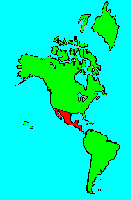SPECIES INFO
Yucatan bobwhite or Black throated bobwhite (Colinus nigrogularis) is found from Yucatan, Mexico south to Guatemala and Honduras. This less than 8 inch male bobwhite has a black throat. The male has a black breast marked with numerous white markings. The face is white with a black eyestripe and a brown cape. The female is more subdued. Her face is pale yellow and marked with a brown eyestripe and a brown cape. Her breast is white marked heavily with brown markings.
With this small range, it is surprising that there are four different subspecies. The nominate subspecies is found in Yucatan. The subspecies caboti is found in Campeche, Mexico. The subspecies persiccus is found in northern Yucatan. The subspecies segoviensis is found in Guatemala and Honduras.The bobwhite genus (Colinus) contains 4 species found from the United States south to Colombia and Venezuela. These birds are typically about 8 or slightly more inches in length. This is a complicated group to study, as all species have over 4 subspecies, and one has 20 subspecies. There is not universal agreement on how to divide this complex.
Quail and Pheasant Family (Family Phasianidae) contains 178 species and is usually broken down into three separate subfamilies as follows: New World quails (Odontophorinae); true pheasants (Phasianinae); and Old World quails (Perdicinae). Some authors treat these three subfamilies as full families. Here they are treated as three different families. The New World Quails (Odontophoridae Family) contains about 31 species found only in the New World.
Fowl group (Galliformes order) contains the various chickens and turkey-like birds of the world. There are about 240 different species of fowl known. Many of the wild species are endangered. Several species such as the domesticated chicken and turkey are main food sources in the world. Most fowl are grain eaters and spend a good portion of their life searching for food on the ground. Select species have been domesticated for their beauty and/or edibility, others are considered good game birds.
Aves contains about 8,650 different species of living birds known to science. Each year about one new species is discovered in some remote rain forest or remote island. In addition, scientists have been raising many subspecies to full species status which may raise the species count to 10,000. Birdlife recognizes 10,027 species as of 2011.
However, each year about one species goes extinct. The rate of extinction is increasing, and the rate of new discovery is decreasing, so that the number of bird species will soon begin to decline rapidly. Although different taxonomists would organize the birds differently, there are approximately twenty-seven orders of birds. These orders are broken down into about one hundred and fifty-five different families.
Recent research of the genetic structure of some of the shore birds and owls would indicate that the present organization of orders and families should have some modification.
The birds are a worldwide group of animals that are characterized by having the front limbs modified into wings that are used for flying. Perhaps the most unique feature of the birds is the feathers. These feathers are made up of a central support called a quill and a series of small filaments that are hooked together as barbs.
For many years it was believed that Archaeopteryx discovered in Bavaria was the oldest bird from about 150 million years ago. However, in l986, Sankar Chattterjee, a Texas paleontologist, reportedly discovered a bird in the genus Protoavis that lived about 225 million years ago.
When this project was begun in 1978, we used Austin & Singer for bird taxonomy. Since then, we have adopted many changes, but have kept some older concepts that are still found widely in the literature. Recently, we have used Clements and Howard & Moore. Very recently, we have used Monroe and Sibley for the higher taxonomy of the perching birds.
Backboned Animals (Phylum Chordata) are the most advanced group of animals on earth. These animals are characterized by having a spinal cord or backbone. Most members have a clearly defined brain that controls the organism through a spinal cord. Fish, amphibians, reptiles, birds, and mammals are in this phylum.
Currently, some taxonomists believe that the fish should be divided into two groups (sharks and regular fishes) and that there are some other primitive groups in the phylum such as hagfish or lampreys.
Animal Kingdom contains numerous organisms that feed on other animals or plants. Included in the animal kingdom are the lower marine invertebrates such as sponges and corals, the jointed legged animals such as insects and spiders, and the backboned animals such as fish, amphibians, reptiles, birds, and mammals.

